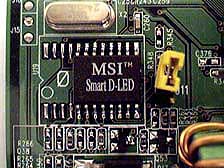Microstar K7T Pro2 KT133 Socket-A ATX
by Henry Kuo on October 16, 2000 12:00 PM EST- Posted in
- Motherboards
 The
K7T Pro2 also features the Smart D-LED technology by Microstar. In case you’re
not faimilar with the D-LED technology, it is basically a set of 4 LEDs mounted
between the serial / parallel ports and the game / sound ports, facing the inside
of the computer. As the system boots, the LEDs blink green and red as different
components are initialized. If everything is successful, all LEDs will finally
turn green. If problems occur, you can use the error code shown by the LED’s
to help identify the problem.
The
K7T Pro2 also features the Smart D-LED technology by Microstar. In case you’re
not faimilar with the D-LED technology, it is basically a set of 4 LEDs mounted
between the serial / parallel ports and the game / sound ports, facing the inside
of the computer. As the system boots, the LEDs blink green and red as different
components are initialized. If everything is successful, all LEDs will finally
turn green. If problems occur, you can use the error code shown by the LED’s
to help identify the problem.
With Smart D-LED technology, when an error occurs during initialization, the speaker sitting right next to the BIOS will tell you what is wrong in plain English or Chinese. Unfortunately, in our sample, neither languages would work, but we were able to hear some noise coming out of the speaker when no memory is installed.

Like the K7T Pro and K7T Master, the K7T Pro2 uses the VIA VT1611A AC97 CODEC to provide some basic sound card features, although for users who care about their 3D PC sound would definitely want a hardware-based PCI sound card for higher quality sound effects.
Bundled with the K7T Pro2 is the new Fuzzy Logic III software. It is mainly a revised version of the Fuzzy Logic II with some bug fixes. This software is Windows based and is currently available for Windows 95/98/Me only. Inside the Fuzzy Logic III, users can read about the information of their CPUs, temperatures, speed of the fan, PCI bus speed, etc… But the most useful feature of this software is increasing or decreasing the FSB of the motherboard, all from within Windows. There are two modes of operation. If users select the auto setting, the software will automatically overclock the CPU, by increasing the FSB one step at a time until the CPU becomes unstable, and then backing off a bit. Users can also use the manual mode where they can input any desire FSB of their choice. Although most of us still prefer to work with the BIOS directly, this definitely provides another media for users who do not feel very comfortable with the BIOS. However, since this software only supports Windows 9x, users of other operating systems will not be able to benefit from it.

Another nice feature from Microstar is the Live BIOS. With the releases of Windows 2000 and Windows Millennium Edition, Microsoft has phased out a true DOS mode, which is essential for traditional BIOS upgrades. Therefore, Microstar includes their Live BIOS software, which connects to the Internet, downloads the latest BIOS, and performs the flash upgrades - all within Windows. Again this is not useful for non-Windows users, but it is a very good start for next generation operating systems.
The manual Microstar includes with the K7T Pro2 contains detailed information on all the jumpers and settings. However, there are only a few instructions on how to install the motherboard, which is essential for new users. Microstar also includes very detailed information on all the BIOS settings, so users can tweak the BIOS accordingly. There are also instructions on how to install the VIA drivers and the AC’97 CODEC. All the software, including Fuzzy Logic III, Live BIOS, and drivers are in the CD Microstar ships with the motherboard.










0 Comments
View All Comments